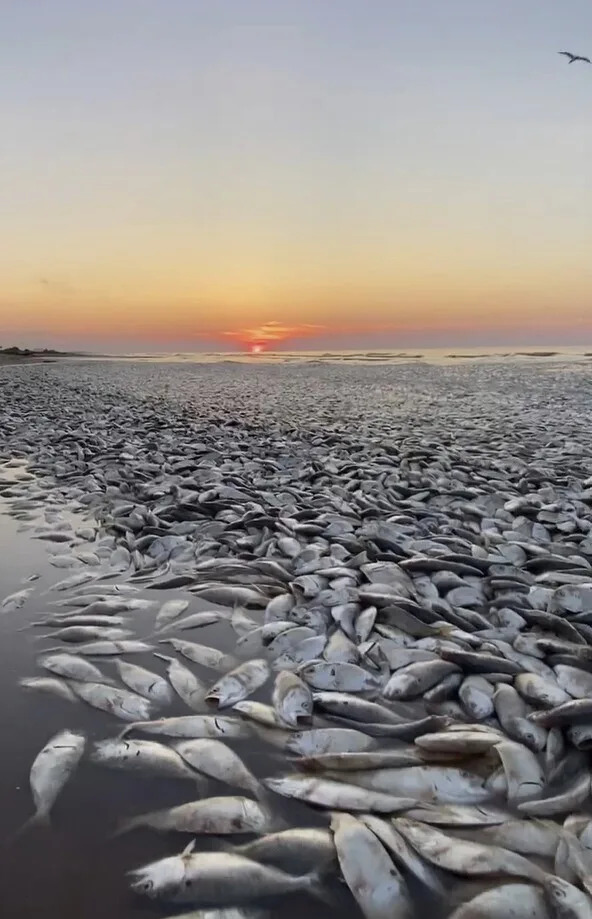Sally Warner, Associate Professor of Climate Science, Brandeis University
Noel Gutiérrez Brizuela, Ph.D. Candidate in Physical Oceanography,
University of California, San Diego
THE CONVERSATION
Tue, June 20, 2023

Satellite data illustrates the heat signature of Hurricane Maria above warm surface water in 2017. NASA
When a hurricane hits land, the destruction can be visible for years or even decades. Less obvious, but also powerful, is the effect hurricanes have on the oceans.
In a new study, we show through real-time measurements that hurricanes don’t just churn water at the surface. They can also push heat deep into the ocean in ways that can lock it up for years and ultimately affect regions far from the storm.
Heat is the key component of this story. It has long been known that hurricanes gain their energy from warm sea surface temperatures. This heat helps moist air near the ocean surface rise like a hot air balloon and form clouds taller than Mount Everest. This is why hurricanes generally form in tropical regions.
What we discovered is that hurricanes ultimately help warm the ocean, too, by enhancing its ability to absorb and store heat. And that can have far-reaching consequences.
Tue, June 20, 2023

Satellite data illustrates the heat signature of Hurricane Maria above warm surface water in 2017. NASA
When a hurricane hits land, the destruction can be visible for years or even decades. Less obvious, but also powerful, is the effect hurricanes have on the oceans.
In a new study, we show through real-time measurements that hurricanes don’t just churn water at the surface. They can also push heat deep into the ocean in ways that can lock it up for years and ultimately affect regions far from the storm.
Heat is the key component of this story. It has long been known that hurricanes gain their energy from warm sea surface temperatures. This heat helps moist air near the ocean surface rise like a hot air balloon and form clouds taller than Mount Everest. This is why hurricanes generally form in tropical regions.
What we discovered is that hurricanes ultimately help warm the ocean, too, by enhancing its ability to absorb and store heat. And that can have far-reaching consequences.

How hurricanes draw energy from the ocean’s heat. Kelvin Ma via Wikimedia, CC BY
When hurricanes mix heat into the ocean, that heat doesn’t just resurface in the same place. We showed how underwater waves produced by the storm can push the heat roughly four times deeper than mixing alone, sending it to a depth where the heat is trapped far from the surface. From there, deep sea currents can transport it thousands of miles. A hurricane that travels across the western Pacific Ocean and hits the Philippines could end up supplying warm water that heats up the coast of Ecuador years later.
At sea, looking for typhoons
For two months in the fall of 2018, we lived aboard the research vessel Thomas G. Thompson to record how the Philippine Sea responded to changing weather patterns. As ocean scientists, we study turbulent mixing in the ocean and hurricanes and other tropical storms that generate this turbulence.
Skies were clear and winds were calm during the first half of our experiment. But in the second half, three major typhoons – as hurricanes are known in this part of the world – stirred up the ocean.

Microstructure profilers are used to measure ocean turbulence. This one is designed and built by the Ocean Mixing Group at Oregon State University. Sally Warner
That shift allowed us to directly compare the ocean’s motions with and without the influence of the storms. In particular, we were interested in learning how turbulence below the ocean surface was helping transfer heat down into the deep ocean.
We measure ocean turbulence with an instrument called a microstructure profiler, which free-falls nearly 1,000 feet (300 meters) and uses a probe similar to a phonograph needle to measure turbulent motions of the water.
What happens when a hurricane comes through
Imagine the tropical ocean before a hurricane passes over it. At the surface is a layer of warm water, warmer than 80 degrees Fahrenheit (27 degrees Celsius), that is heated by the sun and extends roughly 160 feet (50 meters) below the surface. Below it are layers of colder water.
The temperature difference between the layers keeps the waters separated and virtually unable to affect each other. You can think of it like the division between the oil and vinegar in an unshaken bottle of salad dressing.
As a hurricane passes over the tropical ocean, its strong winds help stir the boundaries between the water layers, much like someone shaking the bottle of salad dressing. In the process, cold deep water is mixed up from below and warm surface water is mixed downward. This causes surface temperatures to cool, allowing the ocean to absorb heat more efficiently than usual in the days after a hurricane.
For over two decades, scientists have debated whether the warm waters that are mixed downward by hurricanes could heat ocean currents and thereby shape global climate patterns. At the heart of this question was whether hurricanes could pump heat deep enough so that it stays in the ocean for years.

These illustrations show what happens to ocean heat before, during, after and many months after a hurricane passes over the ocean. Sally Warner, CC BY-ND
By analyzing subsurface ocean measurements taken before and after three hurricanes, we found that underwater waves transport heat roughly four times deeper into the ocean than direct mixing during the hurricane. These waves, which are generated by the hurricane itself, transport the heat deep enough that it cannot be easily released back into the atmosphere.
Implications of heat in the deep ocean
Once this heat is picked up by large-scale ocean currents, it can be transported to distant parts of the ocean.
The heat injected by the typhoons we studied in the Philippine Sea may have flowed to the coasts of Ecuador or California, following current patterns that carry water from west to east across the equatorial Pacific.
At this point, the heat may be mixed back up to the surface by a combination of shoaling currents, upwelling and turbulent mixing. Once the heat is close to the surface again, it can warm the local climate and affect ecosystems.
For instance, coral reefs are particularly sensitive to extended periods of heat stress. El Niño events are the typical culprit behind coral bleaching in Ecuador, but the excess heat from the hurricanes that we observed may contribute to stressed reefs and bleached coral far from where the storms appeared.

Coral reefs are essential habitat for fish and other sea life, but they are threatened by rising ocean temperatures. James Watt via NOAA
It is also possible that the excess heat from hurricanes stays within the ocean for decades or more without returning to the surface. This would actually have a mitigating impact on climate change.
As hurricanes redistribute heat from the ocean surface to greater depths, they can help to slow down warming of the Earth’s atmosphere by keeping the heat sequestered in the ocean.
Scientists have long thought of hurricanes as extreme events fueled by ocean heat and shaped by the Earth’s climate. Our findings, published in the Proceedings of the National Academy of Sciences, add a new dimension to this problem by showing that the interactions go both ways — hurricanes themselves have the ability to heat up the ocean and shape the Earth’s climate.
This article is republished from The Conversation, an independent nonprofit news site dedicated to sharing ideas from academic experts.
It was written by: Noel Gutiérrez Brizuela, University of California, San Diego and Sally Warner, Brandeis University.
Read more:
Atlantic hurricane season 2023: El Niño and extreme Atlantic Ocean heat are about to clash
Hurricane Ida turned into a monster thanks to a giant warm patch in the Gulf of Mexico – here’s what happened
Noel Gutiérrez Brizuela receives funding from the Mexican Council for Science and Technology (CONACYT).
Sally Warner has received funding from the National Science Foundation and the Office of Naval Research.
‘The Atlantic is definitely on fire’: Unusually hot ocean sparks up early hurricane season
Alex Harris
On average, the tropical Atlantic is running about two degrees Celsius hotter than normal, or about 3.6 degrees Fahrenheit, according to NOAA satellite data. And it happened fast.
Micheal Fischer, an assistant scientist with the University of Miami-NOAA Cooperative Institute for Marine and Atmospheric Studies, said that between April to June, the region (including the eastern Caribbean) warmed about 1.6 degrees Celsius. In a normal year, he said, it warms about 1 degree in that same time.
“That’s greater than anything we’ve seen over the last 40 years,” he said. “The Atlantic is definitely on fire.”
Many spots have flashed past an important benchmark that usually doesn’t happen until later in the season — 26.5 degrees Celsius, the threshold scientists use to determine whether water is warm enough to support a tropical storm or hurricane.
Kim Wood, an associate professor of meteorology at Mississippi State University, called the rate of rising sea surface temperatures in the tropical Atlantic “mind-boggling.”
“We need a lot more than warm ocean water for [tropical cyclones] to form, and 26.5°C isn’t a hard-and-fast threshold, but seeing [sea surface temperatures] already exceed that value for so much of this region is... unusual, as many others have noted,” Wood tweeted.
And those pockets of abnormally hot water are already occupied. On Tuesday, the hurricane center was tracking both Tropical Storm Bret as well as another tropical wave close behind it. Hurricane models also had begun to hint at a third wave that could follow.
Why is it so hot?
The latest storm to form, Bret, is weird in several ways. For one, it’s way early.
Typically, the front half of hurricane season features storms that form in the Caribbean and spiral north. That flips around in late July or early August, when conditions line up for that infamous conveyor belt of tropical waves off Africa’s west coast. Some of those strengthen into tropical storms or hurricanes as they head west across the warming Atlantic.
Bret actually formed further to the east than any other early season named storm. Since 1850, only four previous storms have churned up east of the chain of Caribbean islands known as the Lesser Antilles in June.
Forecasters said the abnormally hot waters of the Atlantic could have definitely helped make that possible, but they aren’t the only factor.
“It’s a key ingredient but it’s not the only thing going on,” Fischer said.
Saharan Dust also tends to tamp down the tropics in the early summer. That cloud of loose dirt that floats off the west coast of Africa in the early summer typically slows or shuts down storm formation, blocking the sun and helping keep ocean waters cool. There’s less of that dust than usual this month.
There also are weaker than usual trade winds. Typically this time of year, a high-pressure system sits between Bermuda in the Azores, with a clockwise flow of air around it that helps cool the waters of the Atlantic.
“It’s fair to say the Atlantic has been unusually hospitable to tropical cyclone development this year,” Fischer said.

Satellite data show the tropical Atlantic ocean is almost three degrees Celsius hotter than normal, which could spark an active and early hurricane season.
Alex Harris
MIAMI HERALD
Tue, June 20, 2023
The Atlantic Ocean is hot right now. Hotter than it’s supposed to be for this time of year, and hot enough to worry scientists — particularly ones who monitor hurricanes.
Those higher-than-normal temperatures help explain why the National Hurricane Center’s tracking map on Tuesday looked a lot more like a snapshot from August than June. It shows two brewing systems east of the Lesser Antilles, including one that has already reached tropical storm strength, Bret. Named storms in June are rare and past ones have typically popped in the Gulf of Mexico or near the Atlantic coast.
That hot water is the prime suspect for the early season activity, but not the only one.
“There’s no doubt it’s related to the extra heat down there,” said Jeff Berardelli, chief meteorologist for WFLA in Tampa Bay. “We typically wouldn’t have water temperatures that are above the critical thresholds across wide swaths of the tropical Atlantic this early in the season.”
Some spots in the Atlantic are so unseasonably hot, they’re now running at temperatures usually seen in September — which is three, long hot summer months ahead.
Ben Noll, a meteorologist with the National Institute of Water & Atmospheric Research in New Zealand, tweeted a map showing those spots, which include large swaths of the main development region, where Atlantic hurricanes usually form from waves rolling off the coast of Africa.
Tue, June 20, 2023
The Atlantic Ocean is hot right now. Hotter than it’s supposed to be for this time of year, and hot enough to worry scientists — particularly ones who monitor hurricanes.
Those higher-than-normal temperatures help explain why the National Hurricane Center’s tracking map on Tuesday looked a lot more like a snapshot from August than June. It shows two brewing systems east of the Lesser Antilles, including one that has already reached tropical storm strength, Bret. Named storms in June are rare and past ones have typically popped in the Gulf of Mexico or near the Atlantic coast.
That hot water is the prime suspect for the early season activity, but not the only one.
“There’s no doubt it’s related to the extra heat down there,” said Jeff Berardelli, chief meteorologist for WFLA in Tampa Bay. “We typically wouldn’t have water temperatures that are above the critical thresholds across wide swaths of the tropical Atlantic this early in the season.”
Some spots in the Atlantic are so unseasonably hot, they’re now running at temperatures usually seen in September — which is three, long hot summer months ahead.
Ben Noll, a meteorologist with the National Institute of Water & Atmospheric Research in New Zealand, tweeted a map showing those spots, which include large swaths of the main development region, where Atlantic hurricanes usually form from waves rolling off the coast of Africa.
On average, the tropical Atlantic is running about two degrees Celsius hotter than normal, or about 3.6 degrees Fahrenheit, according to NOAA satellite data. And it happened fast.
Micheal Fischer, an assistant scientist with the University of Miami-NOAA Cooperative Institute for Marine and Atmospheric Studies, said that between April to June, the region (including the eastern Caribbean) warmed about 1.6 degrees Celsius. In a normal year, he said, it warms about 1 degree in that same time.
“That’s greater than anything we’ve seen over the last 40 years,” he said. “The Atlantic is definitely on fire.”
Many spots have flashed past an important benchmark that usually doesn’t happen until later in the season — 26.5 degrees Celsius, the threshold scientists use to determine whether water is warm enough to support a tropical storm or hurricane.
Kim Wood, an associate professor of meteorology at Mississippi State University, called the rate of rising sea surface temperatures in the tropical Atlantic “mind-boggling.”
“We need a lot more than warm ocean water for [tropical cyclones] to form, and 26.5°C isn’t a hard-and-fast threshold, but seeing [sea surface temperatures] already exceed that value for so much of this region is... unusual, as many others have noted,” Wood tweeted.
And those pockets of abnormally hot water are already occupied. On Tuesday, the hurricane center was tracking both Tropical Storm Bret as well as another tropical wave close behind it. Hurricane models also had begun to hint at a third wave that could follow.
Why is it so hot?
The latest storm to form, Bret, is weird in several ways. For one, it’s way early.
Typically, the front half of hurricane season features storms that form in the Caribbean and spiral north. That flips around in late July or early August, when conditions line up for that infamous conveyor belt of tropical waves off Africa’s west coast. Some of those strengthen into tropical storms or hurricanes as they head west across the warming Atlantic.
Bret actually formed further to the east than any other early season named storm. Since 1850, only four previous storms have churned up east of the chain of Caribbean islands known as the Lesser Antilles in June.
Forecasters said the abnormally hot waters of the Atlantic could have definitely helped make that possible, but they aren’t the only factor.
“It’s a key ingredient but it’s not the only thing going on,” Fischer said.
Saharan Dust also tends to tamp down the tropics in the early summer. That cloud of loose dirt that floats off the west coast of Africa in the early summer typically slows or shuts down storm formation, blocking the sun and helping keep ocean waters cool. There’s less of that dust than usual this month.
There also are weaker than usual trade winds. Typically this time of year, a high-pressure system sits between Bermuda in the Azores, with a clockwise flow of air around it that helps cool the waters of the Atlantic.
“It’s fair to say the Atlantic has been unusually hospitable to tropical cyclone development this year,” Fischer said.

Satellite data show the tropical Atlantic ocean is almost three degrees Celsius hotter than normal, which could spark an active and early hurricane season.
Uncertain season ahead
Despite the unseasonably hot waters, early forecasts from NOAA and others have called for a near-average hurricane season. That’s because of another massive weather phenomenon that is known to curtail storm activity — El Niño.
El Niño officially began earlier this month, and years with this weather pattern usually see fewer storms form in the Atlantic and more storm-shredding wind shear in the eastern Caribbean. That works directly against the storm-intensifying power of hotter oceans, leaving scientists with a lot of uncertainty about what this season may hold.
“We’re really in uncharted waters,” Fischer said.
And all of that is on top of the steadily building impact of climate change, which has already warmed tropical oceans by about 2 degrees Fahrenheit since the 1900s.
On Tuesday, NOAA noted that the ocean last month broke heat records, making it “virtually certain” that 2023 would end up in the top ten hottest years on record.
“This year shows us the potential of climate change,” Berardelli said. “When you take climate change and then on top of it you add natural factors that just happen to line up to create warm temperatures, you’re reaching extremes you’ve never reached in modern history.’
Despite the unseasonably hot waters, early forecasts from NOAA and others have called for a near-average hurricane season. That’s because of another massive weather phenomenon that is known to curtail storm activity — El Niño.
El Niño officially began earlier this month, and years with this weather pattern usually see fewer storms form in the Atlantic and more storm-shredding wind shear in the eastern Caribbean. That works directly against the storm-intensifying power of hotter oceans, leaving scientists with a lot of uncertainty about what this season may hold.
“We’re really in uncharted waters,” Fischer said.
And all of that is on top of the steadily building impact of climate change, which has already warmed tropical oceans by about 2 degrees Fahrenheit since the 1900s.
On Tuesday, NOAA noted that the ocean last month broke heat records, making it “virtually certain” that 2023 would end up in the top ten hottest years on record.
“This year shows us the potential of climate change,” Berardelli said. “When you take climate change and then on top of it you add natural factors that just happen to line up to create warm temperatures, you’re reaching extremes you’ve never reached in modern history.’






















